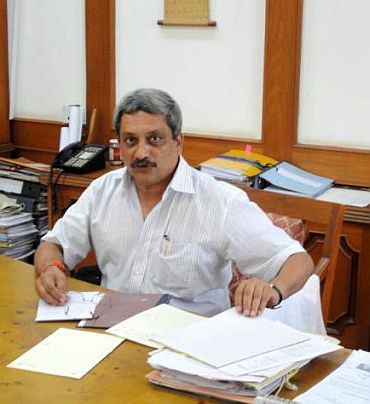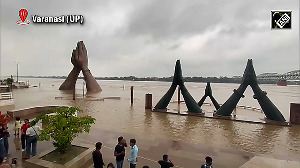 Our large military requirements make for an enormous buyer's leverage, which the defence ministry fritters away in piecemeal purchases
Our large military requirements make for an enormous buyer's leverage, which the defence ministry fritters away in piecemeal purchases
Few tears will be shed, especially in the corridors of power, given his frequent gaffes, if Defence Minister Manohar Parrikar makes good his threat not to talk to the media for the next six months. Speaking less will give Parrikar more time to think and to grasp fundamental defence issues that still elude him. Seven months after his appointment -- when he boasted that swift action was his speciality and that, as an Indian Institute of Technology graduate, he would quickly master technology-related issues -- the new defence minister remains the new defence minister.
Alarmingly for someone who Prime Minister Narendra Modi has anointed a central pillar of the ‘Make in India’ policy, Parrikar has evinced neither the will nor the domain expertise needed to transform a military culture of buying foreign weaponry into one that promotes indigenous arms.
This lack of leadership was painfully exposed this fortnight, when the army rejected the plan to develop its next tank in the country, instead inviting international companies to design a tank for India and supervising its construction. This would waste 30 years of Indian toil in designing and building the Arjun tank, an experience that must be harnessed into a more capable, next-generation tank. The Defence Research and Development Organisation is already working on such a tank -- dubbed the Future Main Battle Tank -- that the defence ministry told Parliament in 2010 would be ready by 2020. Yet the army has scuppered this project, with Parrikar watching helplessly from the side-lines.
The reason is obvious. Parrikar and his bureaucrats prefer to buy than to build, since the latter involves active government leadership in coordinating the accumulation of diverse capabilities that go into a weapons platform. In building the Arjun tank, for example, the DRDO started with little expertise and with a technologically primitive domestic industry. As it painstakingly learnt how to design a tank, many of the sub-systems -- such as the engine, transmission, fire control and night-vision systems -- remain imported.
Meanwhile, Indian companies built others -- such as the armour, gun, ammunition and suspension system -- labouring alongside the DRDO to master these new technologies. An ecosystem now exists for tank production in India, even though the government failed to support these so-called ‘Tier-I’ and ‘Tier-II’ vendors (systems and sub-system suppliers) morally, technologically and financially. Meanwhile, the army did all it could to scuttle the Arjun’s evolution instead of partnering the DRDO.
After the Arjun outperformed the army’s Russian T-90 tank in comparative trials in Rajasthan in 2010, the generals adopted a new tack. Complaining that the 60-tonne Arjun was too heavy, they demanded an improved Arjun Mark II. Incredibly, the additional capabilities demanded added up to another five tonnes.
Parrikar is failing the country and Modi’s vision of ‘Make in India’, by standing by while the army scuttles the Arjun’s successor. He must exercise leadership by calling in the army, the DRDO and captains of industry, both public and private, and telling them flatly that the days of importing Russian armoured vehicles is over, and that a family of Indian tanks, infantry combat vehicles, reconnaissance vehicles and missile carriers will take their place. He must ensure they hammer out time-lines and financing, and allocate responsibility for who will build what and by when. Such decisions require the exercise of subjective judgement by decision-makers, not the time-consuming, timid ‘out’ of competitive tendering. Private industry must be given ownership of intellectual property they develop and, crucially, assured profits from mass-producing the components and sub-systems they develop. Liberal taxation regimes must be uniformly applied across industry. Untenable notions of “national security”, long misused by the public sector to keep out private sector competition, must be thrown overboard. Messrs Tata, Godrej and Mahindra, and chief executives of the other private firms, are as good Indians as the heads of public sector behemoths.
This meeting must be inaugurated with the ceremonial burning of the ‘Defence Procurement Procedure’, which could be retrospectively renamed ‘The Book of Reasons to Do Nothing’. To Parrikar’s credit, he has declared that a lack of trust was impeding his ministry’s functioning and the procurement manual embodies mistrust, with its preoccupation on procedures rather than outcomes. With the DPP out of the way, a ‘Manual of Standards’ must be introduced to specify uniform parts that could be used across various defence platforms. The Russian military uses the same bolt to fasten wheels on to trucks, tanks and helicopters; and the same air blower is fitted in ships, aircraft and land systems. This makes for cheaper volume manufacture and eases logistics and stocking.
This big-picture combat vehicle project must encompass futuristic versions of all the military’s current fleet, drawing in projects like the Future Infantry Combat Vehicle proposal that have meandered along for years like lost and forlorn cows. Each type must be overseen by a project manager, with unreasonable delay penalised with sacking. Parrikar himself - being an IIT graduate -- should chair six-monthly or annual review meetings to monitor progress.
The minister must evolve a similar big-picture approach to untangle the army’s biggest current problem -- the shortage of battlefield fire support, like artillery. Parrikar’s current solution is to expedite several individual procurements, each of a different gun type -- including a 155-millimetre towed gun; mounted gun system; ultra-light howitzer; and two self-propelled gun types. Even though several indigenous initiatives are under way - including a successful Ordnance Factory Board gun; a DRDO-led project called the Advance Towed Artillery Gun; and more than one Indian private sector solution -- Parrikar has failed to coordinate and synergise those by taking a step back and re-evaluating fire support de novo. Such a step could also factor in new equipment like the improved Pinaka rocket launcher, cruise missiles and the Prahar missile, all of which would enhance fire support to the front-line soldier. India could add another deadly dimension to its battlefield fire support by asking Washington for the A-10 Thunderbolt II (nicknamed Warthog) aircraft - a proven battlefield beast that the United States Army custom-built to pour fire on to enemy front lines, even in the face of retaliatory ground fire. With the United States close to retiring its Warthogs, we could evaluate the benefits of acquiring this legendary aircraft at throwaway prices under the “Excess Defense Articles” category.
Such a holistic approach would benefit not just the indigenising of systems but also import, where it is inescapable. Our large military requirements make for an enormous buyer’s leverage, which the ministry fritters away in piecemeal purchases. The navy needs sonars and torpedoes for multiple types of surface and submarine vessels, but all these are imported separately, linked with individual warship contracts. Instead, our requirement of 100-odd sonars and several hundred torpedoes could easily be processed as separate contracts, with global vendors strong-armed into building in India for the global market.
This is equally true for air force procurements. If the ministry views the big picture of our fighter requirements, rather than as individual “procurement cases”, major indigenisation of sub-systems and systems could be obtained from bundling the development and production of the Tejas light fighter, Advanced Medium Combat Aircraft, Fifth Generation Fighter Aircraft, Multi-Role Transport Aircraft and a host of helicopters that the military requires.
All this, of course, requires Parrikar to take a step back and look afresh at the unimaginative way we do our procurement. Hopefully, his silence will now give him the time.












